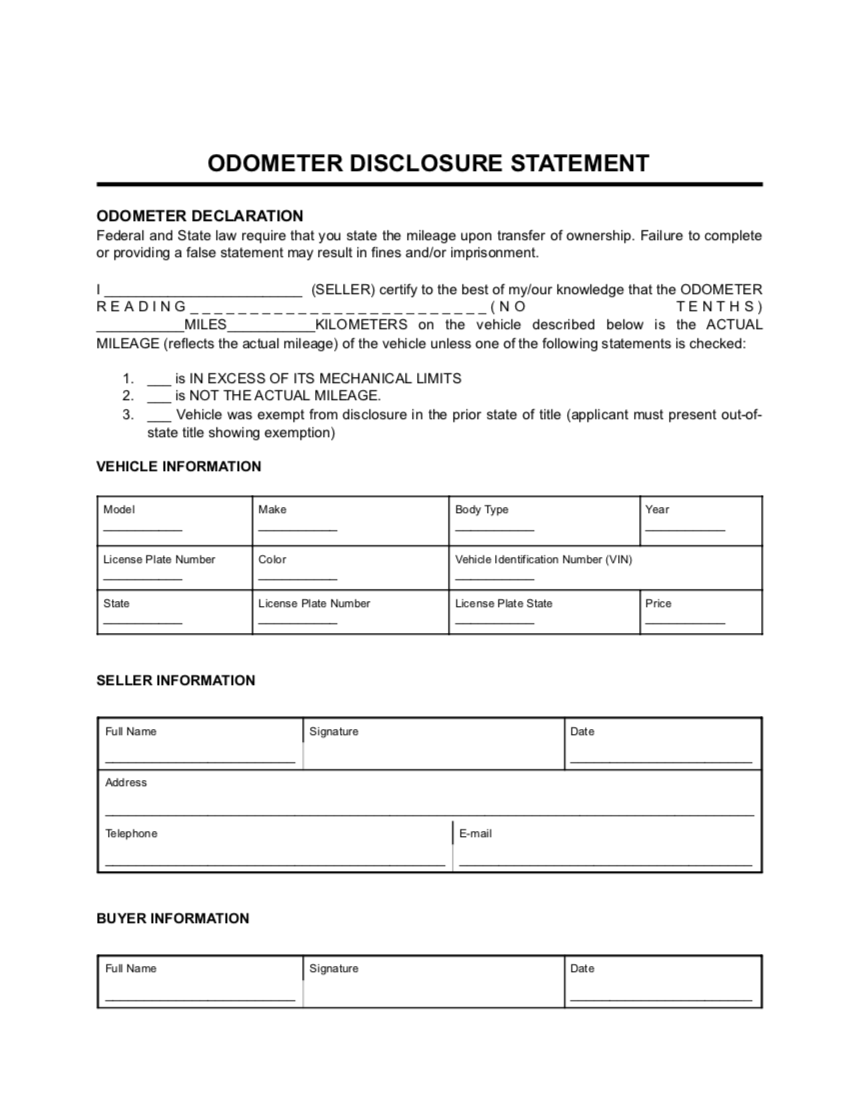An odometer disclosure statement provides an official report of the mileage of a vehicle at the time of sale.
Because vehicles with higher mileage are usually worth less, some unscrupulous sellers may tamper with the odometer for a higher sale price. The disclosure statement aims to prevent odometer fraud.
Federal Law
The details and requirements of odometer disclosure statement forms vary from state to state, so checking the state requirements before creating your own is essential. The federal law that governs disclosure requirements for transferred motor vehicles is 49 U.S. Code § 32705.
What Is an Odometer Disclosure Statement?
An odometer disclosure statement is a document recording the current mileage on your vehicle. Your state’s Department of Motor Vehicles (DMV) may provide a state-specific form, or you can use a generic template.
Odometer disclosure statements often ask for detailed information in a particular format. Your DMV or local equivalent establishes the formatting for this document. These agencies aim for continuity for quick and uniform application of signatures, seals, and other internal information. Some counties have their own forms, as well.
The seller should disclose the mileage and attach the appropriate form with the vehicle bill of sale and other documentation when registering as the vehicle’s new owner.
Odometer Disclosure Statements by State
Many states and counties have different odometer disclosure statement forms. However, some states choose to use the federal format. Here’s an overview of the requirements in each state:
| State | Odometer Reading Required? | State Law | Form |
|---|---|---|---|
| Alabama | Yes, if vehicle is newer than 2011, under 16,000 pounds, and self-propelled. | Alabama Department of Revenue | Form MVT 5-5 |
| Alaska | Yes, if vehicle is newer than 2011, with an un laden weight less than 12,000 pounds, and self-propelled. | 2 Alaska Admin. Code § 92.220 | Form 839 |
| Arizona | Yes, if vehicle is newer than 2011, under 16,000 pounds, and self-propelled. | Ariz. Rev. Stat. § 28-2058 | Federal Form |
| Arkansas | Yes, if vehicle is newer than 2011, under 16,000 pounds, and self-propelled. | AR Code § 4-90-206 | Included in the Bill of Sale |
| California | Yes, if vehicle is newer than 2011, under 16,000 pounds, and self-propelled. | California DMV Chapter 5: Vehicle Industry Registration Procedures Manual | Form REG 256 |
| Colorado | Yes, if vehicle is newer than 2011 and under 16,000 pounds. | Federal Law | Federal Form |
| Connecticut | Yes, if vehicle is newer than 2011 and under 16,000 pounds. | Federal Law | Federal Form |
| Delaware | Yes, if vehicle is newer than 2011 and under 16,000 pounds. | Del. Code tit. 21 § 6408 | Federal Form |
| District of Columbia | Yes, if vehicle is newer than 2011, under 18,000 pounds, and self-propelled. | D.C. Code § 50-506 | Federal Form |
| Florida | Yes, if vehicle is newer than 2011, under 16,000 pounds, and self-propelled; exempt after 20 years. | Fla. Stat. § 319.225 | Form HSMV 82042 |
Washington state prints its odometer disclosure statement forms on tamper-proof paper, which is unavailable online. Instead, you can pick one up at your local vehicle licensing office or call the Washington State Department of Licensing to mail it to your address.
How to Fill Out an Odometer Disclosure Statement
Follow these steps to fill out an odometer disclosure statement:
- Write the buyer’s and seller’s information, including their names, addresses, phone numbers, and emails.
- Record the odometer reading and indicate if the figure is in miles or kilometers.
- Clarify if the mileage was in excess of its mechanical limits or if it isn’t the actual mileage. You can also explain if the vehicle was exempt from disclosure in the prior state of title.
- Provide the vehicle’s information, including its model, make, body type, year, license plate number, color, VIN, license plate number, and price.
When completing an odometer disclosure statement, you can fill out a separate form or, if your state allows, write it on the bill of sale or in the corresponding section of the vehicle’s title.
Odometer Disclosure Statement Sample
If you live in a state that accepts the federal format, you can download an odometer disclosure statement template below in PDF or Word format:

Frequently Asked Questions
Is It Okay to Replace an Odometer?
It’s legal to repair, service, or replace your odometer if you ensure the new device displays the same mileage as the old one.
Can an Odometer Have an Incorrect Reading?
An odometer can have an incorrect reading due to intentional and accidental causes. For example, adding larger tires than your vehicle’s manufacturer recommends can cause the odometer to show a reading with fewer miles because each rotation of a larger tire covers more distance.
Other reasons for incorrect odometer readings include the following:
- Odometer fraud
- Accidental resets
- Mechanical failures
- Electrical issues
What If the Owner Doesn’t Know the Vehicle’s Mileage?
The owner should make a full disclosure if they don’t know the vehicle’s true mileage. They can provide an estimate by referencing old service paperwork and inspection documents, but they must ascertain it’s not an exact figure.
Are Odometers in Miles or Kilometers?
It depends on the country where the vehicle is advertised and sold. Countries that use the imperial system for measurement will likely have their vehicles’ odometers display the distance traveled in miles. Countries using the metric system will likely have odometers display the distance in kilometers.

